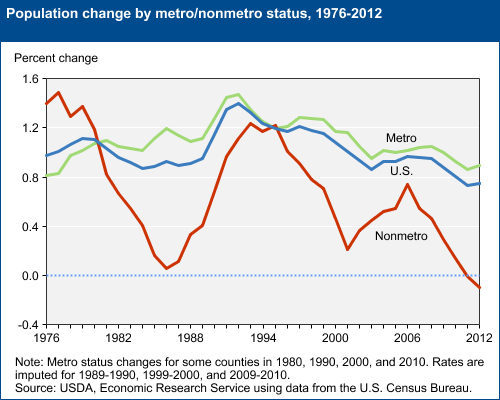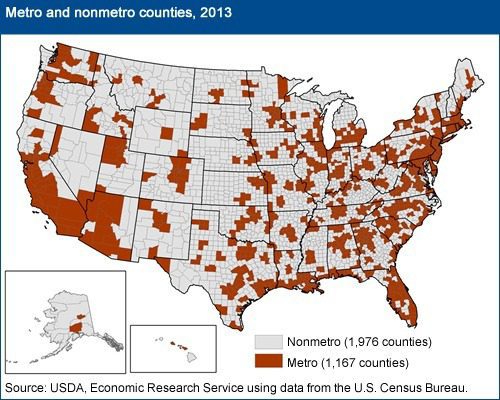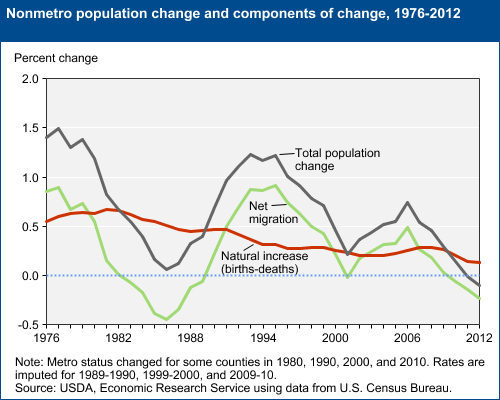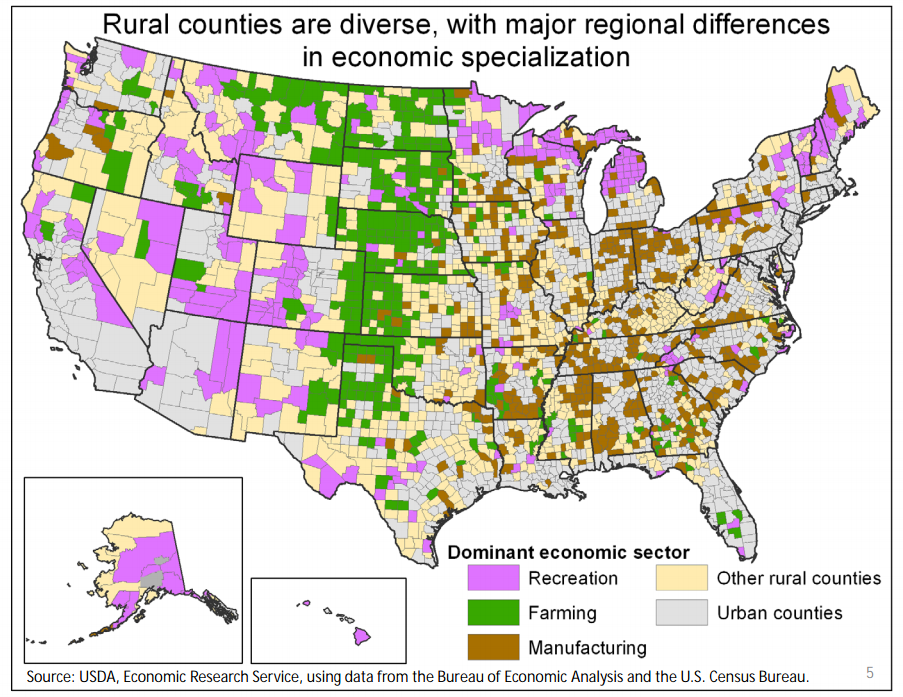SALEM, Ohio — As America continues its slow, but steady, economic recovery, some parts of the country are being left behind, according to the USDA’s report Rural America at a Glance.
The report, published annually by the USDA’s Economic Research Service (ERS), highlights social and economic conditions in America’s non-metro, or rural, counties. It’s a sort of check-up on the health of rural America, and the results published in the latest report were grim.
Job growth, population
According to the report, rural America’s job growth is stagnant and the population is in decline. In fact, it’s the first time such a population decline has been recorded in the nation’s rural counties.
A loss of .09 percent, or about 44,000 people, was recorded between April 2010 and July 2012. That number may seem small, but it could represent a big change in America.
“What’s surprising is how quickly it changed from net population gain to population losses,” said Mark Partridge, who has a Ph.D. in economics and studies rural-urban interdependence at Ohio State University.
Partridge referred to the population gains rural areas experienced in the 1990s, during the “rural rebound.”
To put the recent exodus in perspective, think about this: According to the 2011 version of the report, between 2000 and 2010, nonmetro population grew by 2.2 million people. In the 1990s, during the ‘rural rebound,’ nonmetro population grew by 5.3 million.
But, not only is rural America losing population, America, as a whole, is becoming less rural.
What is nonmetro?
ERS researchers classify a county as metro if it: “contains a designated urbanized area of 50,000 or more people or that has large commuting flows to or from an adjacent county with at least one such urbanized area.”
“Nonmetro” counties are outside the boundaries of those metro areas.
ERS researchers further subdivide nonmetro into “micropolitan, or micro” areas, which are nonmetro labor-market areas centered on urban clusters of 10,000-49,999 persons and defined with the same criteria used to define metro areas; and “noncore” counties, which are all remaining counties.
Over time, areas can change, so every 10 years researchers reevaluate counties. If a county grows rapidly enough, it becomes reclassified as metro and vice versa, if a county begins shrinking.
In March 2013, 113 nonmetro counties were classified as metro, and 36 counties switched from metro to nonmetro. The switch shrunk rural America by some 4.8 million people. However, population loss due to reclassification doesn’t impact the agency’s final number.
Aside from the shrinking size of rural America, why are rural residents leaving?
What gives?
John Cromartie, a geographer with the Resource and Rural Economics Division at the USDA, thinks several things are impacting rural population loss.
One factor could be a change in residential preferences.
“We’re seeing population growth in central cities and a slowdown of suburbinization.”
According to the U.S. Census Bureau estimates, the nation’s largest 25 metro areas saw a 2.2 percent population growth from 2010-2012. Smaller metro areas grew at a slower rate at 1.7 percent.
People are trading the comfort of the suburbs for the hustle and bustle of the city.
“Population growth in high-amenity areas like beaches, mountains, and skiing areas has slowed,” said Cromartie.
Historically, migration to scenic areas of the country has bolstered rural America’s population, but that influence is weakening.
Jobs, jobs, jobs
Another factor affecting rural America’s population decline is the job market.
During the recent recession, metro and nonmetro areas saw the number of employed people fall by just over 5 percent. Industries like construction and manufacturing were the hardest hit.
The sharpest employment declines were in the Southeastern United States and in the industrial areas of the Midwest. About 300,000 nonmetro manufacturing jobs were lost in 2008 alone.
Although, things could have been worse. Partridge said that the recession could’ve impacted rural America more if it wasn’t for a ‘massive commodity boom’ and a ‘minimal housing bust.’ Home prices weren’t as inflated in rural areas as they were in cities and suburbs.
Recovery?
Rural America may have been spared the worst of the losses during Great Recession, but what about the gains made during the recovery?
Metro and nonmetro areas alike began recovering jobs in 2010. But job growth in nonmetro counties has since stalled.
“Rural America is lagging in the recovery to some extent. Housing and manufacturing are not yet as strong as they were pre-recession,” said Partridge.
Not only are manufacturing jobs lagging, but high-skill, high-paying jobs reside elsewhere.
A report released by the Federal Reserve Bank of New York, Workforce Skills across the Urban-Rural Hierarchy, found that urban centers tend to offer high-skilled and high-paying occupations.
Rural areas, however, have larger concentrations of “makers” or occupations like machinists, builders and laborers, professions that have a, “relatively flat earnings trajectory” according to the report.
The USDA report came to the same conclusion. The average wage for workers in nonmetro areas was about 20 percent lower than in metro areas.
Poverty rates remain stubbornly high in nonmetro areas, as well. In 2012, nonmetro areas had a 17.7 percent poverty rate.
Not a chicken or the egg scenario
Low-paying jobs are particularly worrisome to the nation’s young people, and they’re leaving rural areas in response to the tepid job growth.
As of 2012, 33.5 percent of 25- to 29-year-olds had at least a bachelor’s degree.
Those graduating in 2012 carried an average of $29,000 in debt, according to a report by the Institute for College Access & Success’ Project on Student Debt.
Not surprisingly, young people are making up much of the population gains in cities.
The census shows that young adults 25-29 are moving out-of-state. Many young adults landed in cities like Washington D.C., Denver and Portland, Ore., where high tech jobs are demanding highly skilled workers.
Young people leaving rural areas is nothing new though, “Even when times are good, rural areas typically lose population those few years after high school” said Cromartie.
The shrinking rural population is not unprecedented, according to Partridge. In the 1950s and ’60s, there was a mass exodus from rural areas to cities, but that migration was offset by the baby boom. Today, however, the birthrate isn’t high enough to offset out migration.
Challenges ahead
In November, Agriculture Secretary Tom Vilsack released a statement about the ERS report’s findings. He said the report, “highlights the critical need for a new Food, Farm and Jobs Bill that will help to reverse troubling demographic and economic patterns in Rural America.”
He continued by adding, “This is just one reminder that we need a national commitment to create new opportunities in rural America that keeps folks in our small towns and reignites economic growth across the nation.”
There is hope in some rural towns in the form of new horizontal oil and gas well drilling. The boom has uplifted communities in Texas, eastern Ohio, Pennsylvania and in the Northern Great Plains.
But many counties still lost population despite the energy boom. In the end, it all depends on where you live.
Partridge is “modestly optimistic” about rural America’s future, but he warns some areas may want to switch from an expansion and growth model to a model of decline.
He’s hesitant to declare the population loss a crisis, saying more data is needed to come to any conclusions.
Cromartie, however, said that the population migration is a long-term trend that isn’t about to change.
“We’ll see more of this in the future.”
Edits:
- The headline was revised from “Is rural America struggling? Rural population losses a long-term trend” to “Is rural America struggling? Rural population decline reflects impact of recession,” to clarify that although net migration out of rural America has been increasing since 2006, resulting in an overall decrease in population, rural America didn’t see an overall loss of population, due to natural births, until 2010.















“Rural population losses a long-term trend” – the data shows explicitly that this is the FIRST time rural populations are declining yet you declare this a long term trend in the headline. As a statistician, I am confused. I would like to point you to another, more positive trend, of people age 30-50 moving TO rural communities. http://z.umn.edu/braingain
Hi Ben,
You’re right about the headline. It’s a bit definitive, isn’t it? That will be revised.
I’m taking a look at your research right now. It’s encouraging to see rural Minnesota doing so well! As I said in the article, it all depends on where you live. Population growth (and loss) is very uneven across rural America. In fact, I’ll be adding a paragraph to help clarify that as soon as possible.
What is rural Minnesota doing to attract professionals? Maybe other rural communities can learn from Minnesota.
Thanks so much for the feedback,
Will
Hello Will, thanks for your reply. This trend is not unique to Minnesota. In the “Continuing the trend” report it details this happening across the nation. Personally, I am more interested in the midwest / great plains – but you see in the maps that even in the panhandle of Nebraska, where there are large overall population losses, there are still gains in the 30-50 age cohorts. The story is of loss AND gain, its just that the kids leaving the small towns (which really isn’t a problem and is healthy from a social capital perspective) and the seniors moving to regional centers (for health care presumably) outweigh those moving in.
Add transportation costs to the reasons people are moving to more urban areas. Gasoline has doubled since 2006, many who lived in more rural areas found they could not afford the drive to work.